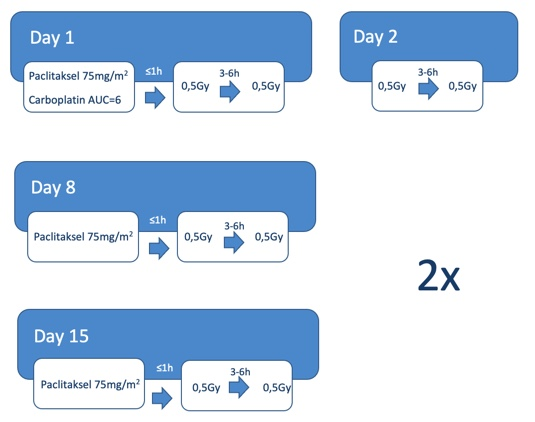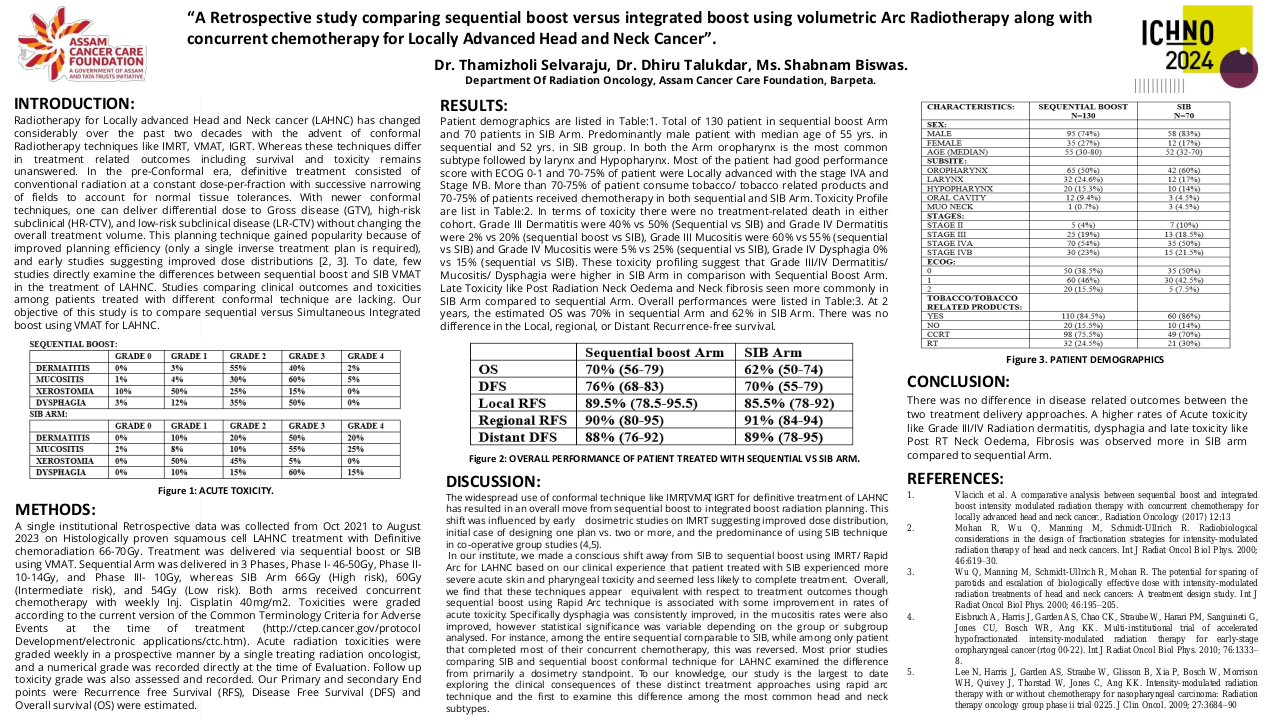Induction radiochemotherapy with low dose fractionation XRT in patients with advanced HNSCC.
Purpose/Objective
Supported by the National Science Centre, Poland, 2020/39/O/NZ5/02625.
Induction chemotherapy (iCH) although is not a standard approach, is often used in clinical practice for patients with advanced head and neck cancer (HNSCC). Tumor regression is a potential goal of induction treatment to reduce target volume in the second stage of treatment – radiochemotherapy or radiotherapy.
In this study the most common iCH, TPF (docetaxel, cisplatin, and 5-fluoruracil) has been replaced with two-drugs regimen combined with low-dose radiation. Complementary mechanisms of action and excellent radiation sensitization of drugs together with hyperradiosensitivity (HRS) phenomenon of low-dose fractionated radiation therapy may be beneficial for patients with bulky disease. Additionally, lower toxicity could be expected for two-drugs modality. Preliminary results on effectiveness and toxicity has been presented.
Material/Methods
The group consisted of 27 patients treated due to advanced HNSCC in National Research Institute of Oncology, Gliwice branch between 2020 and 2023. There were 23 (85%) men and 4 (15%) women in the median age of 60 years. In most cases primary tumor site was oropharynx followed by hypopharynx and CUP in 17 (63%), 7 (26%) and 3 (11%) cases respectively. All patients presented advanced stage - III stage in 16 cases (59%) and IV stage in 11 cases (41%). HPV- positive tumors were found in 13 (48%) patients. There were 2 cycles of iCHT consisting of carboplatin (AUC 6) and paclitaxel (75 mg/m2) combined with low-dose radiotherapy 2 x 0.5 Gy on days 1, 8 and 15. Additionally, two doses of 0.5 Gy was given on day 2. CT ,MRI and PET-CT scans were performed to estimate the staging of the cancer, all according to the 8th edition of the TNM classification for malignant tumors.
The volume of the primary tumor and metastatic lymph nodes were estimated in cm3 before and after induction radiochemotherapy with low dose fractionation radiotherapy to analyze the potential value of tumor volume regression . After ICHRTL, all patients were qualified for the second stage of treatment - radiochemotherapy in 24 cases and radiotherapy in 3 cases, respectively. To investigate the presence of HRS effect, fibroblasts were irradiated in vitro with doses ranging from 0.1 to 4 Gy (6-MV X-ray beam) and cell radiosensitivity was estimated by flow cytometry-based clonogenic survival assay and RIANS test (pATM and H2AX foci assays).
Results
Clinical and experimental data will be presented.The mean volumes of tumor and metastatic lymph nodes among 27 patients before ICHRTL were 32.5 cm3 (Vt) and 45.1 cm3 (Vn) , respectively. After ICHRTL, these mean values were 17.2 cm3 (Vt) and 22.2 cm3 (Vn). Wilcoxon test analize showed significant decrease in T volume (Vt) and N volume (Vn) before and after iCHRTL (p=0.003) and p=0.00008) respectively. Due to complications 16 patients (60%) did not receive the full dose of chemotherapy and radiotherapy (ICHRTL). Leukopenia and neutropenia occurred in 12 (44%) and 11 (40%) patients respectively. Poor drug tolerance (vomiting, nausea, abdominal pain) was observed in 3 (11%) patients, and renal failure in 1 (4%) patient. Among normal skin fibroblasts assessed from 21 patients two demonstrated HRS effect.
Conclusion
The use of ICHRTL in patients with advanced HNSCC is a low-toxicity and effective method. The obtained regression of tumor volume (Vt) and metastatic lymph nodes (Vn) in most patients managed to reduce the high dose area in the second stage of treatment (radiotherapy/radiochemotherapy). Further observations are needed to estimate the potential role of decrease in T volume (Vt) and N volume (Vn) after ICHRTL on the expected survival of patients.
1.Posner MR, Haddad RI, Wirth L, Norris CM, Goguen LA, Mahadevan A, Sullivan C, Tishler RB. Induction chemotherapy in locally advanced squamous cell cancer of the head and neck: evolution of the sequential treatment approach. Semin Oncol. 2004 Dec;31(6):778-85. doi: 10.1053/j.seminoncol.2004.09.007. PMID: 15599855. 2. Gleason JF Jr, Kudrimoti M, Van Meter EM, Mohiuddin M, Regine WF, Valentino J, Kenady D, Arnold SM. Low-dose fractionated radiation with induction chemotherapy for locally advanced head and neck cancer: 5 year results of a prospective phase II trial. J Radiat Oncol. 2013 Mar 1;2(1):35-42. doi: 10.1007/s13566-012-0074-3. PMID: 26052405; PMCID: PMC4457337.3. Dey S, Spring PM, Arnold S, Valentino J, Chendil D, Regine WF, Mohiuddin M, Ahmed MM. Low-dose fractionated radiation potentiates the effects of Paclitaxel in wild-type and mutant p53 head and neck tumor cell lines. Clin Cancer Res. 2003 Apr;9(4):1557-65. PMID: 12684432. 4. Arnold SM, Kudrimoti M, Dressler EV, Gleason JF Jr, Silver NL, Regine WF, Valentino J. Using low-dose radiation to potentiate the effect of induction chemotherapy in head and neck cancer: Results of a prospective phase 2 trial. Adv Radiat Oncol. 2016 Jul 14;1(4):252-259. doi: 10.1016/j.adro.2016.06.003. PMID: 28740895; PMCID: PMC5514161.







